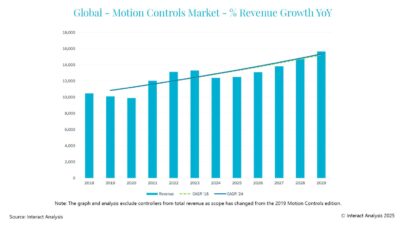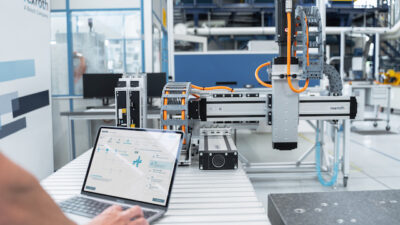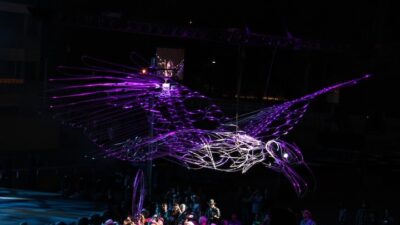Unlike extrusion, which squeezes material through a mold, a pultrusion machine takes fiber material like carbon or glass, impregnates it with resin, and pulls it through a die that shapes it as desired. A chemical reaction occurs as material passes through the heated die. The result is a hardened product, which can be used in ladders, reinforcing panels, chemical-resistant grating, and other co...
Unlike extrusion, which squeezes material through a mold, a pultrusion machine takes fiber material like carbon or glass, impregnates it with resin, and pulls it through a die that shapes it as desired. A chemical reaction occurs as material passes through the heated die. The result is a hardened product, which can be used in ladders, reinforcing panels, chemical-resistant grating, and other commercial infrastructure products.
Through the die
Although material type affects how it is handled before it enters the die, (amount of heat applied differs for carbon fiber and fiber glass), the basic process is the same: two 4-ft long hydraulic cylinders pull the fiber through. Each pulling cylinder actuates an independently moving carriage on a rail. A hydraulic clamping cylinder on each carriage moves a platen (clamp) that squeezes down on the hardened material and holds it as the cylinder pulls (models range in pull and clamp force from 10,000 to 100,000 lb).
Threading the die is time-consuming, so once the machine is set up and starts pulling parts, machine operators want to keep it running as long as possible. High quality output relies on maintaining a consistent chemical process, which requires pulling fiber at a constant velocity (1 to 96in./min., depending on machine). If the handoffs by the pulling cylinders are not smoothly coordinated, fiber material could bunch up or be compressed, decreasing quality.
Entec Composite Machines Inc. of Salt Lake City, UT, a division of carbon fiber manufacturer Zoltek Corp., makes pultrusion machinery. To improve control of the pulling process, Entec recently upgraded its line of pultrusion machines to use an electronic motion controller. Previous Entec machines used a programmable logic controller (PLC) to output an analog voltage to servo valves driving the pulling cylinders. Pulling velocity was manually set by potentiometers according to the material being pulled, and the two pulling systems had to be individually set and manually adjusted by operators.
To replace the old velocity controls, Entec selected an RMC75P programmable motion controller from Delta Computer Systems Inc. (Vancouver, WA). Delta model RMC75P is a two-axis controller that outputs a variable control voltage to each of the two proportional servo valves of the pulling cylinders to precisely control the pulling velocity.
Entec’s machine uses Profibus to transfer information about speed, operating mode, and commands between a Siemens PLC that performs overall machine control and the motion controller (Delta RMC75P comes standard with a Profibus interface). The PLC tells the RMC what mode to go into, including selection among multiple pulling modes, and adjusts commands for machine operators, such as a command to “jog” the axes into a particular position.
Entec was introduced to Delta controllers through hydraulic distributor Interstate Hydraulics (West Jordan, UT). Delta had an application engineer create an example framework for programming the motion controller, including helping with a program scheme to handle the handoffs between pulling cylinders. An Entec engineer fine-tuned the motion control programs and added the program to implement the Profibus interface. Machine operating mode selection is done through an HMI connected to the PLC. The machine has three control panels: for the die heaters, the pulling machine, and the automatic flying cutoff saw.
On this project, Entec chose to use the motion controller to manage only the critical pulling motion. (Delta RMC motion controller could handle all motion axes, from force control of the clamping cylinder to the synchronized motion of the cutoff saw, controlling position, pressure/force, and velocity using electric motors and as hydraulics.) Hydraulics can be controlled to deliver precise results.
www.deltamotion.com , www.entec.com , www.interhydra.com



